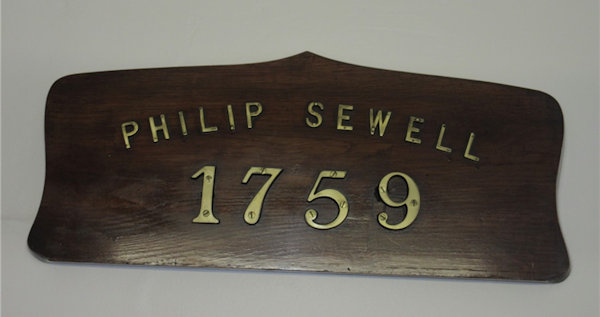By Rosemary Bailey
This article was published in the April 2023 edition of Soul Search, the Journal of The Sole Society
Ian Sewell has passed over all his files associated with the Sewell family and we have started to go through them to see what they contain. I came across a photo of a plaque on the side of the Quaker Meeting House in Beccles, Suffolk which said that the building had been given by Philip Sewell to the Quakers in 1759. The photo had appeared in the journal in 2009, but with no information.

I thought it worth emailing Beccles Quakers and was pleased to be put in touch with the delightful Jill Allum who has provided me with a lot of information about Philip. She has researched in Norwich and Ipswich Record Offices, plus the top Quaker sources in Friends House London. After a few emails going to and fro she wrote a letter to me saying ‘You’ve started something here!, My floor is covered in papers and I can hardly reach my bed. But it’s fun and I am very grateful for you including me in your research’. With the letter was a pamphlet which told the story of Philip and had much information we didn’t know.

A lot of what follows is from Jill’s pamphlet but some births and marriages can be found on Ancestry.com. Jill says that the Quakers kept good records because often they were accused of not paying their tithes.
Philip was baptised on 26th September 1692 at the Monthly Meeting of Woodbridge, Beccles.

His parents were Nicholas (a grocer) and Anne. When you look at the actual image of the document on Ancestry.com a full page comes up which appears to be the record of Philip’s marriage, it is difficult to read but I suspect somewhere it contains his birth date.
Nicolas and Anne went on to have three more children Joseph (1697), Joseph (1712), and one other child who all died. William, born around 1714 survived and is mentioned in Philip’s will.
There is a marriage between a Nicholas Sewell and Anne Younge on 8th October 1686 in Redisham, Suffolk which is only 5.4 miles from Beccles. Is this the marriage of Philip’s parents?
Philip become a grocer like his father and is likely to have sometimes worshipped at Diss and presumably there met Mary Pullyn. They married at Tivitall Meeting in 1723. Philip and Mary had to be visited by two Quaker Elders prior to marrying who gave:- A very satisfactory report in every respect.
Mary’s father was Richard Pullyn, a wealthy wool-dealer. Phillip went into the wool trade too, and became wealthy and owned lands round Beccles, including at Hales, Weston and Ringsfield.
Sadly Philip and Mary’s only two children did not survive. They were buried at Worlingham Quaker Burial Ground.
In 1736 Philip and Mary were living in what is now Lloyds Bank in Beccles High Street, he was an important, wealthy citizen in the town but as a Quaker he wasn’t allowed to be on the Town Council. He did, on occasions, count the number of small pox victims in the town.

As an important Quaker Philip was often chosen to travel to other meetings on weekdays and received visitors from other Meetings. In June 1748 John Griffith from Pennsylvania wrote in his diary: Traveld to Norwitch, dine at Philip Sewells at Becles. Lodge at Joseph Gurneys in Norwitch.
In 1743 the Meeting started to raise money for a new meeting place and burial ground as they had been renting for 70 years. Philip first gave £25 and then bought a cottage and orchard in the middle of Beccles. In the end Philip paid most of the £184. 2s. 3d. for Quaker Cottage but the Monthly Meeting tried to pay it back but were still in debt to him when he died. In 1753 Philip made a gift of land to 12 Quaker Trustees.
In 1744 the Bishop of Norwich gave permission for the Quakers to build a Meeting House for: the dissenting people called the Quakers. The cottage became known as Quaker Cottage. The first burial there is of Philip’s Uncle Abraham in 1746.
In 1746 Philip made his will and he died in December 1759 at age 56. Mary, his wife, died aged 77. In his will Philip left £1200 to his brother William and lands to Mary. The last gift he made was: To the poor of Beccles, such as do not receive any collection, (I leave) 10 cauldron of coals, to be disposed of by Mary during the next winter and £5 in bread.
The original meeting house was only single storey, the upstairs was added in 1912 and at the same time a new hall to seat 120 was built.
